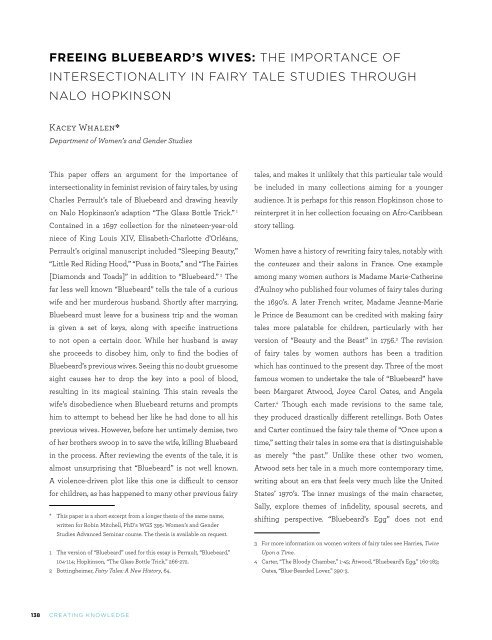UNDERGRADUATE
Ycb5305N2JX
Ycb5305N2JX
Create successful ePaper yourself
Turn your PDF publications into a flip-book with our unique Google optimized e-Paper software.
with a literal death, but more the death of a marriage<br />
as Sally discovers her husband’s infidelity. This lack of<br />
gruesome detail may seem like a drastic departure from<br />
the original, but Atwood’s version is nothing compared to<br />
that of Oates. Rather than have her heroine go through the<br />
forbidden door, the protagonist in “Blue-Bearded Lover”<br />
does not enter the chamber at all. Instead, she chooses<br />
to live her life with Bluebeard and bear his children. This<br />
act reveals the calculating nature of this wife, who would<br />
rather choose to live with evil than attempt to open the<br />
door. In this way, Oates’ protagonist is able to conquer the<br />
figure of Bluebeard and truly take control of her own tale,<br />
even if her actions might seem just as despicable as her<br />
husband’s to the reader. Of the tales authored by women,<br />
the one that perhaps is most true to the original is Carter’s<br />
“The Bloody Chamber,” which may seem surprising since<br />
it is closer to a novella than a fairy tale, which readers<br />
would assume leaves more room for reinterpretation.<br />
While staying true to many of the plot points, Carter<br />
choses to explore areas such as sexuality, female agency<br />
and the effects of poverty on a marriage decision.<br />
These three versions of “Bluebeard” are quite different<br />
from each other, while at the same time being recognizable<br />
as stemming from the same tale. 5 This quick detailing<br />
of these reinterpretations managed to point out the<br />
ways in which the tales were different from the original<br />
“Bluebeard” and from each other; however, what it failed<br />
to mention were the ways in which they are all extremely<br />
similar. Many of the issues changed in these tales revolve<br />
around the female protagonist’s gender and the assets or<br />
limitations that come from it. Part of this similarity could<br />
be explained by the fact that all these authors are largely<br />
famous, all born in the late 1930’s and all white women<br />
who are residing or resided in the United States, Canada<br />
and Europe. Another part of the reason for this intense<br />
focus on the gender of the female protagonists and<br />
5 Fairy tales that all exhibit the same themes and plot summary can<br />
be found using the Aarne-Thompson-Uther classification system.<br />
“Bluebeard” and its variations are considered to be ATU 312 tale types.<br />
little else could come from the field of feminist fairy tale<br />
criticism itself, which had for so long been inundated with<br />
a heavy focus on gender, at the expense of other identities.<br />
While the field of fairy tale criticism had been in existence<br />
for quite some time, feminist fairy tale criticism did<br />
not occur until the beginning of the second wave of<br />
feminism. 6 It was in 1970 that Alison Lurie published<br />
the article that would lead to the creation of the field, by<br />
claiming fairy tales were beneficial to young girls. 7 Lurie<br />
comes out strongly on the side of both folk and fairy tales,<br />
arguing that they are full of strong female characters,<br />
hidden in popular and less popular stories. It is due<br />
to the male domination of the literary world, through<br />
careful selection, editing and publication of only certain<br />
tales that women had been keep in the dark for so long<br />
about these female characters, ripe for idolization. Lurie<br />
advocates not for the tales that we might be familiar with<br />
today, but instead “traditional” tales, which she claims<br />
are “exactly the sort of subversive literature of which a<br />
feminist should approve.” 8 This sparked a rebuttal from<br />
Marcia R. Lieberman, who fundamentally disagreed with<br />
Lurie, a move that started what is now termed the Lurie-<br />
Lieberman debate. 9 Lieberman’s article claimed that it<br />
did not matter if there existed obscure female role models<br />
hidden away in neglected fairy tales. These are not the<br />
characters that young girls learn of when undergoing the<br />
process of what it means to be a woman in the United<br />
States. Lieberman writes: “Only the best-known stories,<br />
those that everyone has read or heard, indeed, those that<br />
Disney has popularized, have affected masses of children<br />
in our culture.” 10 She goes on to argue that fairy tales do<br />
the work of teaching young girls that the best thing in<br />
6 This section would not be complete without giving credit to Haase’s<br />
“Feminist Fairy Tale Scholarship,” 15-63. The scope of his survey covers<br />
much more than is mentioned in this paper and I would direct those<br />
further interested there.<br />
7 Lurie, Don’t Tell the Grown-Ups. Parts of this book are a revision of Lurie’s<br />
earlier article “Fairy Tale Liberation,” 42-44.<br />
8 Ibid., 19.<br />
9 Lieberman, “‘Some Day My Prince Will Come,’” 383-4.<br />
10 Ibid., 383-4.<br />
DEPAUL UNIVERSITY<br />
139


